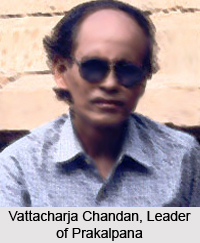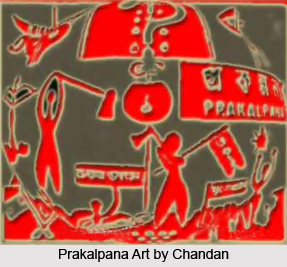 Prakalpana Movement is a significant literary movement which had commenced in the city of Kolkata in West Bengal on 6th September, 1969 which is a crucial breakthrough from the previously existing redundant concepts of existentialism, surrealism, free verses, absurdist literature and other kinds of literary aspects. It blossomed under the leadership of Vattacharja Chandan, who continued his efforts with the aide of two other men named Asish Deb and Dilip Gupta. However, later this day was referred to as `Prakalpana Day` since it is believed that `earth stood absolutely still` on the day of origin of the literary movement. The official journal of Prakalpana Movement was `Swatotsar` and it was named so by Dilip Gupta and published by its founder Vattacharja Chandan. The symbol of Swatotsar resembled an axe blade which represented their revolt against the long existing conventional literary forms.
Prakalpana Movement is a significant literary movement which had commenced in the city of Kolkata in West Bengal on 6th September, 1969 which is a crucial breakthrough from the previously existing redundant concepts of existentialism, surrealism, free verses, absurdist literature and other kinds of literary aspects. It blossomed under the leadership of Vattacharja Chandan, who continued his efforts with the aide of two other men named Asish Deb and Dilip Gupta. However, later this day was referred to as `Prakalpana Day` since it is believed that `earth stood absolutely still` on the day of origin of the literary movement. The official journal of Prakalpana Movement was `Swatotsar` and it was named so by Dilip Gupta and published by its founder Vattacharja Chandan. The symbol of Swatotsar resembled an axe blade which represented their revolt against the long existing conventional literary forms.
The aim of Prakalpana Movement was to introduce an innovative genre of literary style, opposing against the traditional literary forms. As Prakalpana Movement frequently utilizes visuals and graphics, certain literary critics are of the view that pictorial poetries are one of the main highlights of this movement. However, in reality, Prakalpana Movement employs a style of narrative fiction rather than poems though it has been found that some Prakalpana writers have chosen to combine genres in the same writing.
History of Prakalpana Movement
The Prakalpana Movement formally started being popular since the year 1977 and different types of Sarbangin poetries and other forms of Prakalpana literature were also ushered by the movement under a single umbrella in the form of Swatotsar publication. Thereafter following 10 years of its publication, Swatotsar closed down during the year 1979 and by that time it had already published 20 issues, concentrating mainly on `Prakalpana` and `Kobisena`. Avant-garde poems, essays, literary information, letters and reviews were all published as par of the bilingual Prakalpana literature. After the very first publication of Swatotsar, Asish Deb deserted Swatotsar but he returned in the year 2005, to the same magazine. Similarly, even Dilip Gupta left the Prakalpana Movement during 1978 and came back after eight years during the 1980`s.
 This movement was not dependent on financial assistance from the fellow members of the literary group, unlike other movements, and instead has been enriched with the immense contribution of innumerable authors and writers from all across the globe. Shyamoli Mukherjee Bhattacharjee, Nikhil Bhaumik, Dilip Gupta, Shaswata Shikdar, Satya Ranjan Biswas, Uttar Basu, Baudhayan Mukhopadhyay, Asish Deb, Rishin Mitra, Vattacharja Chandan, Niva De, Ramratan Mukhopadhyay, Sukla Mojumdar, Bablu Roy Choudhury and others were actively involved with this movement.
This movement was not dependent on financial assistance from the fellow members of the literary group, unlike other movements, and instead has been enriched with the immense contribution of innumerable authors and writers from all across the globe. Shyamoli Mukherjee Bhattacharjee, Nikhil Bhaumik, Dilip Gupta, Shaswata Shikdar, Satya Ranjan Biswas, Uttar Basu, Baudhayan Mukhopadhyay, Asish Deb, Rishin Mitra, Vattacharja Chandan, Niva De, Ramratan Mukhopadhyay, Sukla Mojumdar, Bablu Roy Choudhury and others were actively involved with this movement.
Certain experimental short stories in Bengali were published following the style of Prakalpana movement, beautified with symbols, pictorial signs, thereby signifying the utilization of non-literary elements. The founder of this movement, Vattacharja Chandan was determined to take it forward despite all the obstacles. Other group members of this movement also supported Chandan in all his efforts of establishing the Prakalpana Movement.
Features of Prakalpana Movement
It is believed that the Prakalpana Movement is amongst the most avant-garde and innovative literary developments in the history of Indian literature, which boasts of a global popularity even till the present day. Several Bengali short stories have been effectively arranged according to the characteristics of the Prakalpana Movement. The liberal utilization of graphics, symbols and ornamentations in modern Indian literature have already been employed by `Kobisenas` and `Prakalpanites` many years ago. Numerous aspects of Prakalpana literature, along with those of `Flow Verse`, `Sarbangin Poetry`, `Chetanavyasism`, etc. have been adopted into the scene of global literature. Many creative works of Prakalpana Movement gained much popularity due to its introduction of non-commercial features and shedding off the styles of mainstream literary characteristics from the stories, poems, etc. Vattacharja Chandan yet wants to strengthen this literary movement with the able cooperation of his team of excellently talented writers and artists. Readers from all the country were attracted to this brand new style of literature and embraced it warmly.
In addition to these artists they have also published the works of eminent writers like Rabindranath Tagore, Mukul Dey, Ram Kinker Baij, Sunil Das, Ramananda Bandyopadhyay, Rabin Mandal, Pranabesh Maity and few more. The first Prakalpana book by Chandan is `Porimandal` that was published on Prakalpana Day. In the early 1970s he developed the Sarbangin Poetry Movement which is known as Chetanavyas.



















